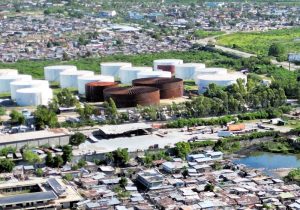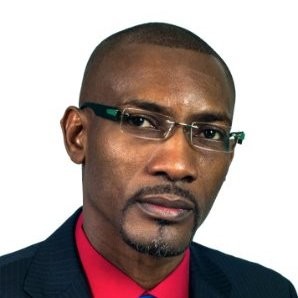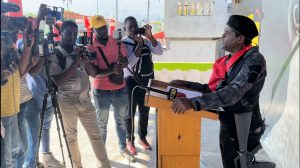(Français)
The misinformation and disinformation surrounding events last week at Port-au-Prince’s Varreux fuel terminal have been quite remarkable, even for Haiti, which rarely has a shortage of either untruth.
Varreux, as it is commonly called, is wedged between two large, God-forsaken shantytowns – La Saline and Cité Soleil – which are largely controlled by the “Revolutionary Forces of the G9 Family and Allies, Mess with One, You Mess with All” (FRG-9), a federation of anti-crime armed neighborhood groups which put up barricades two months ago outside the plant’s gates in solidarity with a nationwide mass movement calling for de facto Prime Minister Ariel Henry to either roll back September fuel price hikes or resign. The terminal consists of 21 oil storage tanks through which an estimated 70% of Haiti’s fuel flows.
First there were the false rumors that the FRG-9 had removed its barricades sometime in late October or that it was stealing and selling gas from inside the terminal. Then there was the bewildering charge that Henry’s government had somehow tasked the FRG-9 with putting its barricades outside the plant to provide a pretext for foreign military intervention.

All of these rumors were contradicted by regular battles around the plant’s gates between the FRG-9 and the Haitian National Police (PNH), which claimed many lives, according to Jimmy “Barbecue” Cherizier, the FRG-9’s spokesman. “Many men, women, and children were victims of gunfire during the fighting,” Cherizier told Haïti Liberté and Redacted in an extended interview. “Some died in the hospital, some died at the scene. And the worst thing in all of it, the [PNH] armored vehicles positioned themselves in the entrance where people died, which didn’t allow us the opportunity to send those victims to the morgue. When their bodies began to decompose, we had to retrieve them, put them in coffins, and bury them.”
The final fierce battle for control of Varreux took place on Thu., Nov. 3, when police, using new armored vehicles from Canada and the U.S. delivered on Oct. 15, entered the terminal. On the morning of Nov. 4, Cherizier told Haïti Liberté that the FRG-9 intended to prevent gas tanker trucks from leaving the terminal, which it had never entered. “It is true that they are inside the terminal and have control of Varreux, but we have taken up positions outside the gates and will continue to stop traffic out until our original demand is met that the price be lowered back down to what it was or that Henry resigns,” he said.
“Harrison betrayed us, we got a knife in the back,” said Cherizier.
Later that day, CNN published an article which implied that the plant had not been lost in a battle but simply turned over to the de facto government after two weeks of negotiations.
The report by Haitian journalist Étant Dupain, a fierce FRG-9 opponent, was based on an interview with politician Dr. Harrison Ernest, the founder and leader of the Construct Life (Konstwi Lavi) party.
“I talked to Barbeque [sic] and told them to leave the terminal because the kids need to go back to school,” Ernest told Dupain. “And we urged the government to do their part to make sure there is fuel and the fuel need [sic] to reach the customer.”
“Harrison betrayed us, we got a knife in the back,” said Cherizier, who grew up with the doctor, a few years his senior, in Delmas 6 and served as his security chief when Ernest was the director of Radio Télévision Nationale d’Haïti (RTNH) in 2014. “In the battle we’re fighting, at no point did we sit down or negotiate with Ariel Henry or send [Ernest] to negotiate for us.”
As a friend, Cherizier used to ask Ernest for advice when preparing an FRG-9 press conference or writing a statement. “He profited from our friendship and the confidence we had in him to go sit down with Ariel Henry… [and] used the G9 name to negotiate,” he told Haïti Liberté. “I don’t know what he negotiated with Ariel Henry, if it was for a job, or money, or a [post of] director general.”
While Cherizier categorically denied that Ernest was ever acting as a “bridge or mediator” for the FRG-9, he did admit that the federation was contemplating a retreat.

“You saw the pictures I sent you of the people who have been killed” in the fighting, Cherizier told Haïti Liberté. “When you are fighting, you have to calculate how much strength you have,” he said. “We’re studying if we have enough strength to prevent the gas from leaving [the terminal]. If we see we don’t have enough strength to stop them, we’ll have to withdraw.”
Two days later, Cherizier held a press conference in La Saline where he publicly announced, in essence, that the FRG-9 had been forced to retreat.
“We in the [FRG-9] are asking all the truck drivers and all the people involved in the question of gas to take all measures to allow the gas to be distributed to the pumps,” he declared, reading from a hand-written statement. “We never negotiated nor sent anybody to negotiate with Ariel Henry. We took this decision among ourselves to allow the gas to flow, and we want the people to know that it’s not a decision we took because we negotiated anything with Ariel Henry.”
Despite the FRG-9 decision to retreat from holding Varreux, the battle continued into the weekend. On the afternoon of Sat., Nov. 5, heavy gunfights again erupted for hours in Cité Soleil.
Cherizier said the clash killed over 40 people and explained his understanding of its cause: “After a meeting where Rose Milard Petit-Frère, the former mayor of Arcahaie, sent money to Ti Gabriel in Cité Soleil’s Brooklyn area, which is [controlled by the criminal gang federation called] G-Pèp, to buy bullets, guns, and to attack us. They also used the police, because Ariel Henry is the head of the CSPN [Supreme Council of the National Police]. Since [leaders] Iscard and Mathias are in Cité Soleil representing the G9, they used the police to attack those guys, and as the police were attacking them in front, Ti Gabriel was attacking them from behind… Gabriel was attacking Iscard, and the police were attacking Belekou [another Cité Soleil neighborhood], they destroyed a lot of houses of poor people with bulldozers. When we learned about this, the G9 had to send reinforcements to G9 members who were in difficulty.”

In short, the FRG-9 again was unable to dislodge Ariel Henry from power through its blockade of Varreux, just as it failed in a similar attempt last year. But now the ball is back in the court of Washington and Ariel Henry, who raised the price of gas in September from 250 gourdes ($2.10) to 670 gourdes ($5.60) per gallon.
“Are the people going to accept to purchase gas at that price?” Cherizier asked in an interview after his press conference. “We’ll be watching to see what reaction the people have… But for some to stop blaming us and telling lies about us, we decided… to cross our arms… and see how they are going to make the people accept that.”










